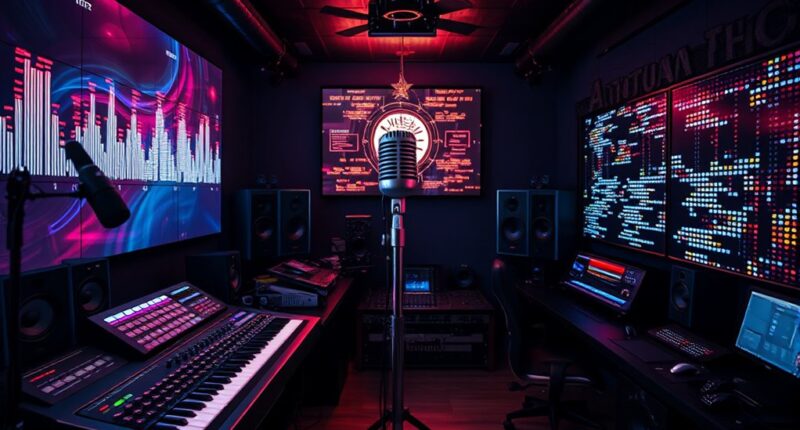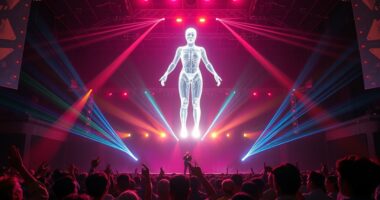Auto-Tune started in the late 1990s as a tool for subtle pitch correction, but Cher’s 1998 hit “Believe” popularized its creative use, giving vocals a robotic edge. Since then, it’s shaped mainstream music, influencing genres like hip-hop and cyberpunk, where it creates high-tech, futuristic sounds. Its evolution from simple hardware to advanced digital systems continues to impact modern vocals and aesthetics. If you explore further, you’ll discover how it rewrites musical and visual worlds.
Key Takeaways
- Auto-Tune was developed in the late 1990s to correct pitch and enable creative vocal effects.
- Cher’s 1998 hit “Believe” popularized Auto-Tune’s use as a distinctive sound.
- It transitioned from subtle correction to a stylistic tool, influencing genres like pop, hip-hop, and cyberpunk.
- Advances in digital signal processing enhanced Auto-Tune’s naturalness and creative potential.
- Today, Auto-Tune is integral to cyberpunk aesthetics, blending futuristic sound design with digital art forms.
The Birth of Auto‑Tune and Early Innovations
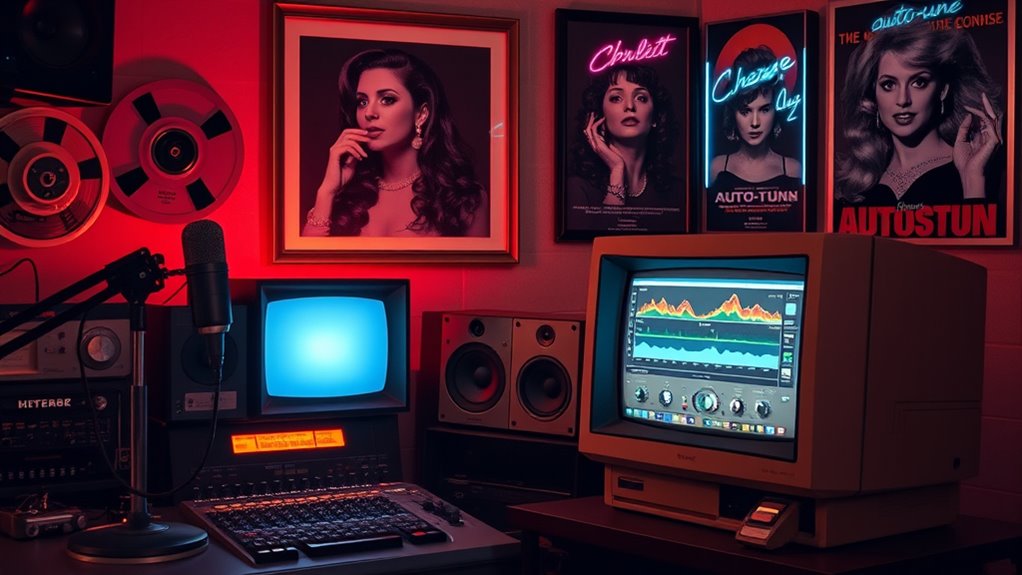
Auto-Tune was born out of a need to correct pitch inaccuracies in vocal recordings, and its early development marked a significant breakthrough in audio technology. This technological innovation revolutionized vocal manipulation, allowing producers to fix pitch issues quickly and efficiently. Initially created in the late 1990s, Auto-Tune used algorithms to adjust vocal pitch in real-time, making it easier to produce polished vocal tracks. Its precision transformed the music industry, giving artists and engineers new creative possibilities. Early versions of Auto-Tune focused on subtle pitch correction, but the technology’s flexibility also enabled more dramatic effects. This innovation laid the foundation for future advancements in vocal editing and set the stage for Auto-Tune’s widespread adoption across genres. It truly changed the way vocals are produced and perceived, with the development of real-time processing playing a crucial role in its success.
Cher’s Iconic Use and the 1998 Breakthrough

Cher’s use of Auto-Tune in her 1998 hit “Believe” catapulted the technology into mainstream consciousness, demonstrating its potential beyond subtle pitch correction. You can hear how it creates a distinct vocal transformation, giving her voice an electronic, almost robotic quality. This was a bold move, showing that Auto-Tune could be used creatively rather than just for fixing pitch errors. Instead of discreet pitch correction, Cher’s song embraced the synthetic sound, making it a defining feature of the track. Her innovative approach helped popularize Auto-Tune not just as a corrective tool, but as an expressive effect. The breakthrough proved that Auto-Tune could shape vocal identity, inspiring artists and producers to experiment with its creative possibilities, forever changing the sound of modern music. Additionally, Cher’s pioneering use of Auto-Tune highlighted how asset division concepts could be creatively applied in various domains, emphasizing the importance of understanding and leveraging technology for artistic expression.
Auto‑Tune’s Rise in Mainstream Music
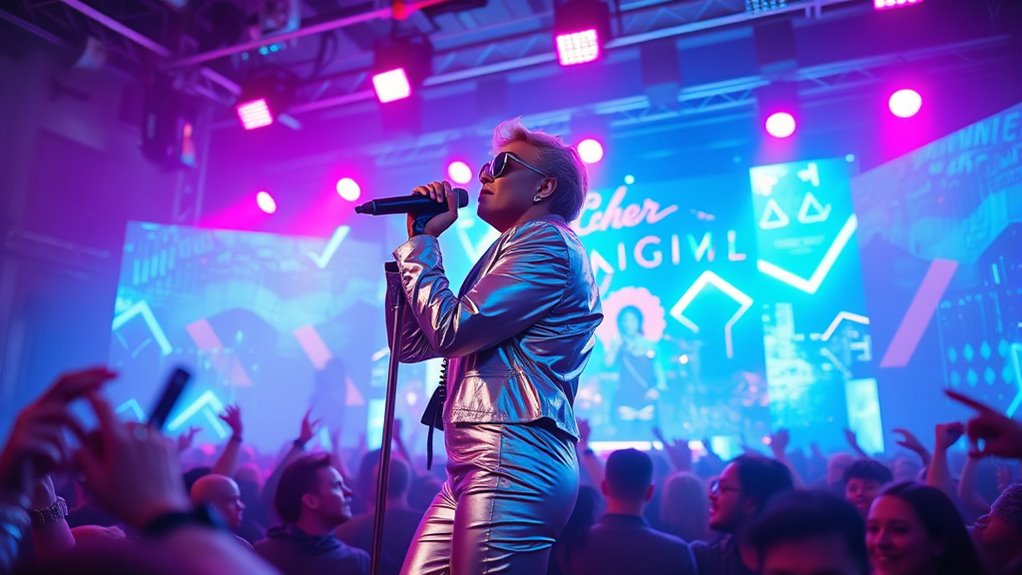
Following Cher’s groundbreaking use of Auto-Tune, the technology steadily gained popularity among mainstream artists and producers. It revolutionized vocal manipulation, allowing singers to achieve flawless pitch correction effortlessly. Studio innovation made Auto-Tune an essential tool, transforming how vocals were recorded and processed. Artists like Daft Punk and T-Pain embraced its capabilities, using Auto-Tune creatively to craft signature sounds. The ease of achieving polished vocal effects encouraged more producers to incorporate Auto-Tune into their workflows, making it a staple in chart-topping hits. Its presence grew beyond niche experiments, shaping entire genres and influencing the sound of mainstream music. As Auto-Tune became more accessible, it shifted from a corrective tool to a creative instrument, cementing its role in modern music production.
Controversies and Artistic Debates

You might wonder if Auto-Tune sacrifices authenticity for perfection in music. Some argue it shapes artistic intent and style, while others see it as a shortcut that changes cultural acceptance and trends. This debate continues to spark feelings about what makes a performance genuine and valuable.
Authenticity Versus Perfection
The use of Auto-Tune has sparked fierce debates about authenticity in music, with critics arguing that it compromises genuine artistry while supporters see it as a tool for creative expression. Some view vocal manipulation as a shortcut that masks a performer’s true talent, questioning whether it diminishes emotional expression. Others argue that Auto-Tune enhances a singer’s ability to convey emotion precisely, allowing artists to craft a perfect vocal performance. This clash centers on whether perfection equals authenticity or if imperfection adds human depth. Ultimately, Auto-Tune challenges traditional ideals, forcing you to reconsider what authenticity means in a world where technological tools can shape emotional resonance. The debate continues, reflecting broader tensions between raw expression and polished precision in modern music.
Artistic Intent and Style
Auto-Tune has sparked fierce debates over artistic intent and style, revealing how technology can both shape and distort a performer’s creative vision. Some see vocal manipulation as a tool for artistic experimentation, allowing artists to push boundaries and craft unique sounds. Others argue it compromises genuine expression, turning vocals into synthetic artifacts that mask raw talent. This controversy centers on whether Auto-Tune enhances or erases authenticity, raising questions about the purpose of vocal performance. Artists like Cher used Auto-Tune to create a signature sound, while others employ it subtly to refine vocal imperfections. Ultimately, Auto-Tune’s role in artistic style remains subjective, fueling ongoing debates about whether it’s a creative innovation or a shortcut that undermines true artistry. Additionally, the use of Auto-Tune in genres like Cyberpunk Rap demonstrates its influence on evolving performance metrics, shaping new cultural and musical landscapes.
Cultural Acceptance and Trends
How has Auto-Tune’s rise influenced its acceptance across different musical communities and audiences? Its widespread use reflects shifting fashion trends, blending technology with artistic expression. Some purists see Auto-Tune as a controversy, arguing it compromises authenticity, while others embrace it as a creative tool. Technological influence plays a key role, enabling artists to craft unique sounds and push artistic boundaries. In mainstream pop and hip-hop, Auto-Tune has become a symbol of modernity and innovation, often associated with cyberpunk aesthetics and futuristic fashion trends. Conversely, critics debate whether it diminishes vocal skill or enhances musical artistry. Overall, Auto-Tune’s cultural acceptance continues evolving, driven by technological advances and changing audience preferences that challenge traditional notions of authenticity and artistic integrity. Additionally, its integration into various genres highlights its versatility as a technological influence that continues shaping contemporary music.
The Evolution of Auto‑Tune Technology
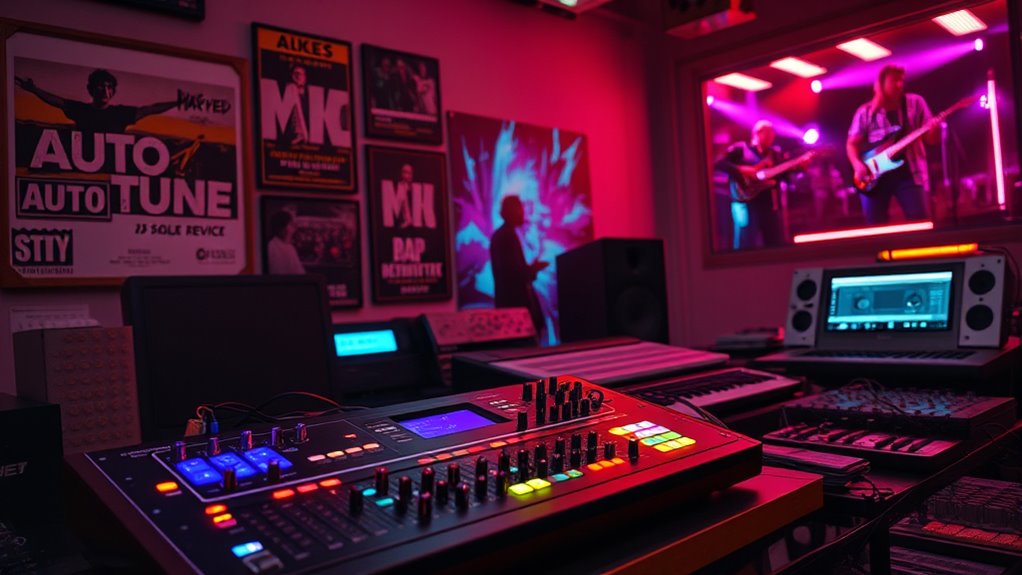
You’ve seen how Auto-Tune started with basic pitch correction tools, but now it’s evolved into sophisticated digital signal processing systems. These innovations have made Auto-Tune faster, more accurate, and more versatile in music production. As it gained popularity, Auto-Tune also became a cultural phenomenon, shaping how we experience modern music. The integration of advanced machine learning algorithms has further enhanced its capabilities, allowing for improved naturalness in vocal processing.
Early Auto‑Tune Innovations
In the early stages of pitch correction technology, you see innovators focusing on tools that subtly fix vocal inaccuracies. During this period, vocoder experimentation played a key role, blending human voice with synthesized sounds to achieve unique effects. Analog synthesis was also prominent, allowing engineers to manipulate audio signals in real-time, producing warmer and more natural corrections compared to digital methods. These early efforts aimed to refine vocal quality without sounding artificial. While not yet fully automated, these innovations laid the groundwork for future auto-tune systems by exploring how to shape and enhance vocal recordings through analog circuits and vocoder techniques. This experimentation set the stage for more advanced, user-friendly auto-tune solutions that would follow.
Digital Signal Processing Advances
The advent of digital signal processing (DSP) marked a pivotal moment in the evolution of auto-tune technology, enabling precise and efficient pitch correction. With DSP, engineers could implement spectral shaping techniques, refining vocal quality and reducing unwanted noise. However, early digital methods sometimes introduced quantization artifacts—unnatural distortions that compromised sound authenticity. Advances in DSP algorithms minimized these artifacts, resulting in smoother pitch progressions and more transparent correction. Modern auto-tune systems now utilize sophisticated spectral shaping to subtly adjust vocal timbre, enhancing clarity without sacrificing naturalness. These developments allowed for more nuanced control, making auto-tune less detectable and more musical. Ultimately, DSP breakthroughs have transformed auto-tune from a simple pitch correction tool into a refined instrument for shaping vocal aesthetics. This progress has been supported by ongoing research in signal processing techniques that continue to enhance audio fidelity.
Auto‑Tune in Popular Culture
Advancements in digital signal processing transformed auto-tune from a technical innovation into a cultural phenomenon. You see it everywhere, shaping trends and influencing media. Here are four ways auto-tune impacts popular culture:
- In auto-tune and fashion, artists adopt auto-tuned vocals as a style statement, emphasizing a futuristic or edgy look.
- Film scores incorporate auto-tune to create surreal, otherworldly soundscapes, enhancing storytelling.
- Musicians and producers use auto-tune to craft signature sounds, making their voices instantly recognizable.
- Cyberpunk and sci-fi genres embrace auto-tune to evoke a high-tech aesthetic, reflecting society’s obsession with digital identity.
- The integration of auto‑tune with digital signal processing techniques has allowed for endless creative possibilities, making it a staple in modern music production.
This evolution underscores auto-tune’s role beyond just pitch correction, embedding it deeply into cultural expressions.
Auto‑Tune’s Role in Digital and Cyberpunk Aesthetics
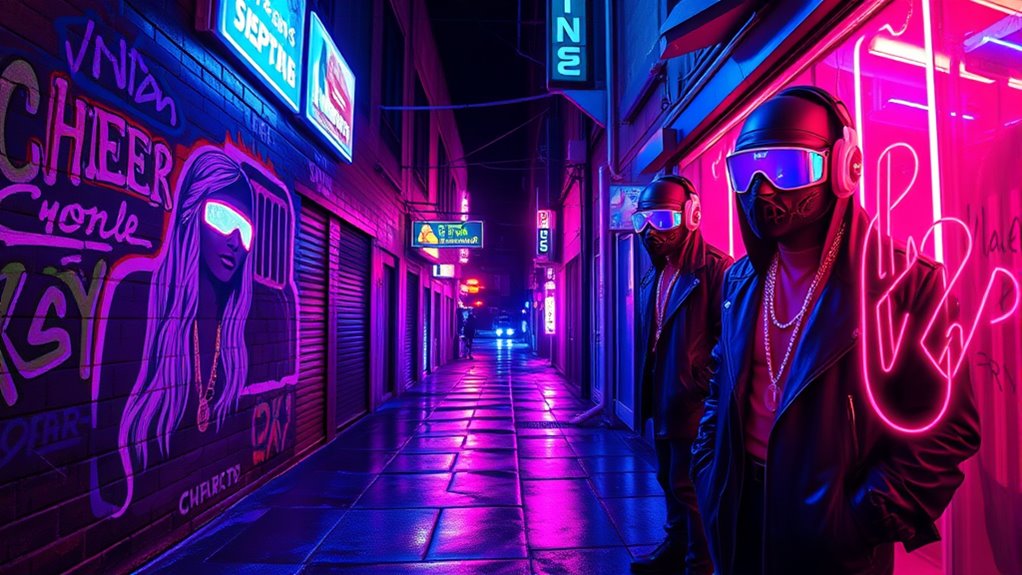
Auto‑Tune has become a defining tool in shaping the digital and cyberpunk aesthetics that permeate modern music and visual culture. Its use of digital manipulation creates an otherworldly, futuristic sound that aligns perfectly with cyberpunk themes. You see this in the way artists distort vocals to evoke a sense of artificiality and technological dominance, emphasizing a cyberpunk aesthetic rooted in high-tech dystopias. Auto‑Tune‘s sleek, robotic effects enhance the visual identity of cyberpunk-inspired media, blending human and machine seamlessly. This technology fuels the genre’s signature look and feel—futuristic, edgy, and hyper-modern—making it a essential element in expressing digital rebellion and technological evolution within cyberpunk aesthetics. It’s a crucial tool for shaping this visually striking, digitally manipulated universe. Additionally, the digital manipulation techniques employed with Auto‑Tune have contributed to the genre’s distinctive soundscape, reinforcing its association with futuristic and dystopian themes.
The Current Landscape: Auto‑Tune in Modern Genres
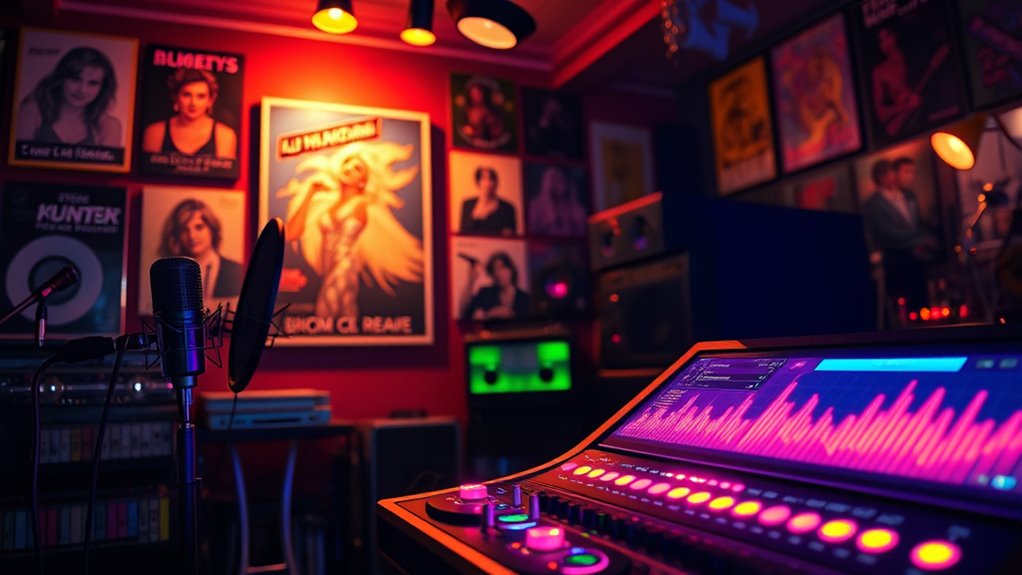
Auto-Tune continues to dominate modern music genres, shaping sounds across pop, hip-hop, R&B, and even indie scenes. You can hear vocal modulation in chart-topping hits, where artists blend genres seamlessly. Here’s what’s happening now:
- In pop, auto-tune smooths vocals and adds futuristic textures.
- Hip-hop artists use vocal modulation to create unique, expressive styles.
- R&B singers blend traditional singing with auto-tuned effects for emotional depth.
- Indie musicians incorporate subtle auto-tune for genre blending, pushing creative boundaries.
- The versatility of auto-tune allows artists to experiment with different effects and textures, expanding the creative possibilities within each genre.
This landscape shows how auto-tune’s versatility fuels genre blending, making vocals more dynamic and innovative. It’s not just about correction anymore; it’s about crafting a signature sound that transcends traditional limits.
Future Trends and the Cultural Impact

As technology continues to evolve, auto-tune’s future shapes new creative possibilities and cultural conversations. In automotive design, artists may explore integrating auto-tune-inspired effects into vehicle sound systems, blending music with car aesthetics. This could lead to personalized soundscapes that reflect individual styles, impacting both entertainment and branding. Additionally, as environmental impact becomes a top priority, future auto-tune applications might focus on reducing energy consumption in digital processing or promoting eco-friendly production methods. The cultural influence will likely expand, with auto-tune inspiring new genres and artistic expressions that challenge traditional notions of authenticity. As you witness these developments, you’ll see how auto-tune continues to redefine the boundaries of music, technology, and cultural identity, shaping the future of creative innovation. Furthermore, advancements in Innovation and Discovery are expected to drive more sustainable and energy-efficient auto-tune technologies, aligning artistic innovation with environmental responsibility.
Frequently Asked Questions
How Did Auto-Tune Influence the Development of Digital Music Production?
Auto-tune revolutionized digital music production by popularizing pitch correction and vocal processing techniques. You can now easily fix pitch issues, creating polished vocals that blend seamlessly with electronic elements. This technology encourages experimentation, allowing you to craft unique sounds and vocal effects. Its influence extends across genres, making music production more creative and accessible, ultimately transforming how artists and producers approach vocal editing and sound design.
What Are the Key Differences Between Auto-Tune and Other Vocal Correction Tools?
You might think all vocal correction tools are the same, but auto-tune stands out with its correction precision and ability to preserve vocal nuance. Unlike other tools that may sound robotic or overly processed, auto-tune offers subtle adjustments that maintain natural expression. It’s designed to subtly enhance your voice without stripping away emotion, making it perfect for artists seeking both accuracy and authenticity in their recordings.
How Has Auto-Tune Affected Live Performances and Concert Experiences?
Auto-tune has transformed live performances by sometimes enhancing vocal clarity, but it also raises concerns about authenticity. You might notice artists using it to correct mistakes, which can influence audience perception—some see it as a tool for better sound, while others feel it diminishes live performance authenticity. Overall, auto-tune‘s presence can make concerts more polished but may also lead fans to question the genuineness of the artist’s talent.
What Are Some Notable Artists Who Intentionally Reject Auto-Tune?
You might be amazed to learn some artists fiercely reject auto-tune, valuing vocal authenticity over digital perfection. Artists like Adele, Chris Cornell, and Ed Sheeran prioritize raw emotion and natural talent, believing auto-tune can diminish genuine expression. Their commitment reminds us that true musical power comes from authentic vocals, inspiring fans to seek honest, heartfelt performances rather than polished, auto-tuned perfection.
How Might Future AI Advancements Change Auto-Tune Technology and Usage?
You might see future AI integration revolutionize auto-tune by enabling even more precise and creative customization. As AI advances, you’ll be able to tweak vocal effects effortlessly, making your sound uniquely yours. This could lead to smarter auto-tune tools that adapt in real-time, giving artists new ways to experiment and perfect their music. Ultimately, AI will make auto-tune more intuitive, flexible, and tailored to your creative vision.
Conclusion
Auto-Tune has transformed your musical world, turning raw voices into shimmering digital dreams. From Cher’s groundbreaking hit to cyberpunk rave sounds, it’s become a double-edged sword—both a tool for innovation and a symbol of controversy. As you listen to today’s artists, remember, Auto-Tune’s evolution is like a river flowing through culture, shaping and reshaping what we think music can be. It’s a mirror reflecting our endless pursuit of sonic perfection.
